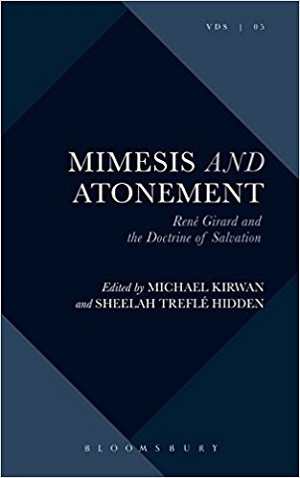 Looking forward to diving into this wonderful collection when it reaches the top of my list. It’s third in line: Mimesis and Atonement: René Girard and the Doctrine of Salvation (Violence, Desire, and the Sacred) by Michael Kirwan and Sheelah Treflé Hidden. Here’s the foreward by Rowan Williams, as succinct a statement of the implications of Girard’s theories for the Christian doctrine of atonement as you’ll find:
Looking forward to diving into this wonderful collection when it reaches the top of my list. It’s third in line: Mimesis and Atonement: René Girard and the Doctrine of Salvation (Violence, Desire, and the Sacred) by Michael Kirwan and Sheelah Treflé Hidden. Here’s the foreward by Rowan Williams, as succinct a statement of the implications of Girard’s theories for the Christian doctrine of atonement as you’ll find:
Rene Girard’s comprehensive and still controversial theories about the origins of culture continue to be discussed in relation to an ever-widening range of disciplines; recent collections of essays have explore their connection with evolutionary biology and neuroscience, as well as with the more familiar areas of anthropology and literary criticism, and an increasing number of studies have looked at the relevance of Girardian analyses to the concrete problems of modern politics and international relations. But the theological agenda has always been a central aspect of Girard’s own concerns and a major area of impact for his theories. Girard has consistently argued that the narrative of the gospel, the narrative of the paradigm case of an expelled and executed innocent, a scapegoat, turns inside out the categories of archaic religion (including the archaic religion that masquerades as modernity). If human culture rests on a ‘founding murder’, the basic act of expelling an arbitrarily designated figure to carry the unbearable tensions of the community outside its boundaries and so remove their burden, then Christianity, to quote Girard’s own formulation is ‘a founding murder in reverse’.
That is not an immediately transparent formulation. But it means something like this: Human beings are – before they realize it, independently of their realizing it – driven again and again to repeat, with ever greater ingenuity, the pattern of foundational violence. Culture goes on reinventing scapegoats, and humans are permanently and paralyzingly involved in this mechanism, struggling to make peace and to secure boundaries by acts of exclusion, which guarantee that anxiety and division will continue. ‘Sacral violence’ is a human addiction, because we have never learnt of ourselves what a community of shared identity might be that was based on something other than this. The uncomfortable truth about a lot of Christian theologies of atonement has been that they claim that there has been one simple and ultimately effective application of sacral violence in the death of Christ. Christ, the innocent carries our sins; he is thus identifiable s ‘the victim we have always been looking for’ – and Girard’s most challenging theological insight is that this is exactly what the death of Christ cannot and must not be.
His argument is that we have to digest a paradox: Christ’s death is the inversion of the mechanism in such a way that it exposes the self-destructive character and irrational nature of the mechanism, rather than satisfying its requirements once and for all. Rather than as the victim we have always been looking for, the supremely effective victim of sacred exclusion, Christ’s effectiveness is in showing that we can be delivered from our addiction to that pattern and establishing another kind of common identity. Our human helplessness is outmaneuvered by a freedom of action that is completely beyond our negotiated efforts to establish peace. The act of God is there first: an act which in its universal invitation and non-exclusionary love holds open the possibility of a communal identity that is shareable by all. This is what the ministry of Jesus already affirms and it is what the events of Easter embody. The new community is not created by the ‘successful’ slaughter of the innocent (which in the gospels is connected with the fragmentation or destruction of the fellowship of Jesus’ followers) but by the triumphant and undeniable reaffirming of Jesus’ proclamation in the resurrection, vindicating his anti-violent gospel and exhibiting the contradictory and death-dealing nature of the scapegoat mechanism itself. Instead of the cross of Christ being the long-awaited answer to our question about how we might ‘finally’ make the mechanism work, it dissolves the entire working of sacral violence and casts the emphasis on the free act of a divine agent beyond all rivalry, negotiation or competition. God is ‘inimitable’ and needs no imitative struggle to attain divine identity; God’s radical generosity is thus uniquely able to expose the self-subverting arbitrariness of human exclusion.
How this maps in detail on to the range of classical Christian theologies of redemption is not a simple matter; some formulations already imply just this paradoxical reversal, some embody in emphatic form precisely the mechanism Girard thinks must be exploded, and it is not straightforward to tell which is which. Some expositions of substitutionary satisfaction may surprise us by effectually subverting their own terms; an apparently liberal bit of exemplarism may lead us straight back into sacral violence of a new kind. We are in need of careful and imaginative readings of our tradition in the light of Girard’s remarkably fertile models – and this is what the present collection splendidly does for us. Atonement theologies can constitute one of the most frustrating areas of doctrinal reflection and analysis, a territory populated by ‘ignorant armies clashing by night’, with stereotypes thrown around and a failure to attend to the detail of argument. Thinking through these questions with Girard on one hand, and the gospel on the other, is (appropriately) a salutary experience. It will not allow us to settle with a theology that simply presents God as responding to the terms in which we put our question, which is always a seduction to be resisted in theology; Girard obliges us to think what difference it might make theologically if we genuinely try to make sense of the act of God in the passion of Jesus as the act of a radical freedom from the fear of otherness, a radical freedom from competition. Whatever account of the redeeming work of Christ we emerge with will at least not be just a repetition of the crudest forms of sacrificial economy – and in recalling us to these basic ‘grammatical’ considerations about how the act of God is to be imagined, it will have implications for many more areas of the theological task, so that this is not just a book about one topic but an invitation to think about the method of a whole discipline. It is a book that should help theology to be more itself.
Advertisements Share this:




